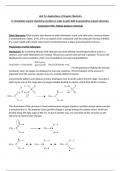Essay
Btec Applied Science Unit 14 Assignment D (Full Assignment)
- Course
- Institution
This is Btec Applied Science Unit 14 Assignment D (Making designer chemicals) which was awarded a distinction and contains all the practical results. This is an example of a Distinction level assignment, and you may use it as a guide to help you achieve a distinction and finish this assignment.
[Show more]



